Cococrete Mixing Instructions
Coco-crete is a low-carbon lime-based composite concrete. Arkitrek have been experimenting with a mix of; coconut coir, river sand, dry hydrated lime, portland cement & water. Lime and cement are destructive to nature because their production necessitates quarrying of limestone. We think that lime-based bio-cretes, such as coco-crete may go some way to mitigating environmental damage.
The following are instructions for mixing a 10:5:4:1 (coir:sand:lime:cement) by volume for a cast in-situ wall.
We have previously experimented with a mix ratio of 10:5:3:2 (coir:sand:lime:cement) by volume. This mix creates a dense concrete-like material with a characteristic compressive strength of around 5N/mm² after 4 months (methodology). This is stronger than we need for self-supporting non-loadbearing walls and we are now optimising the material with less cement.
Health and Safety
Cement and Lime are corrosive alkaline so we recommend wearing boots, long trousers, waterproof gloves and safety goggles for protection. The photo below is of the ‘how not to’ variety. If you get the mix on your skin rinse it off in clean water. If it goes in your eyes, rinse it out thoroughly. Shower after coco-creting and apply moisturising cream where lime/cement has been in contact with your skin. Other on-site risks, such as cutting off toes with a spade, are also present so do your own assessment and take appropriate precautions.
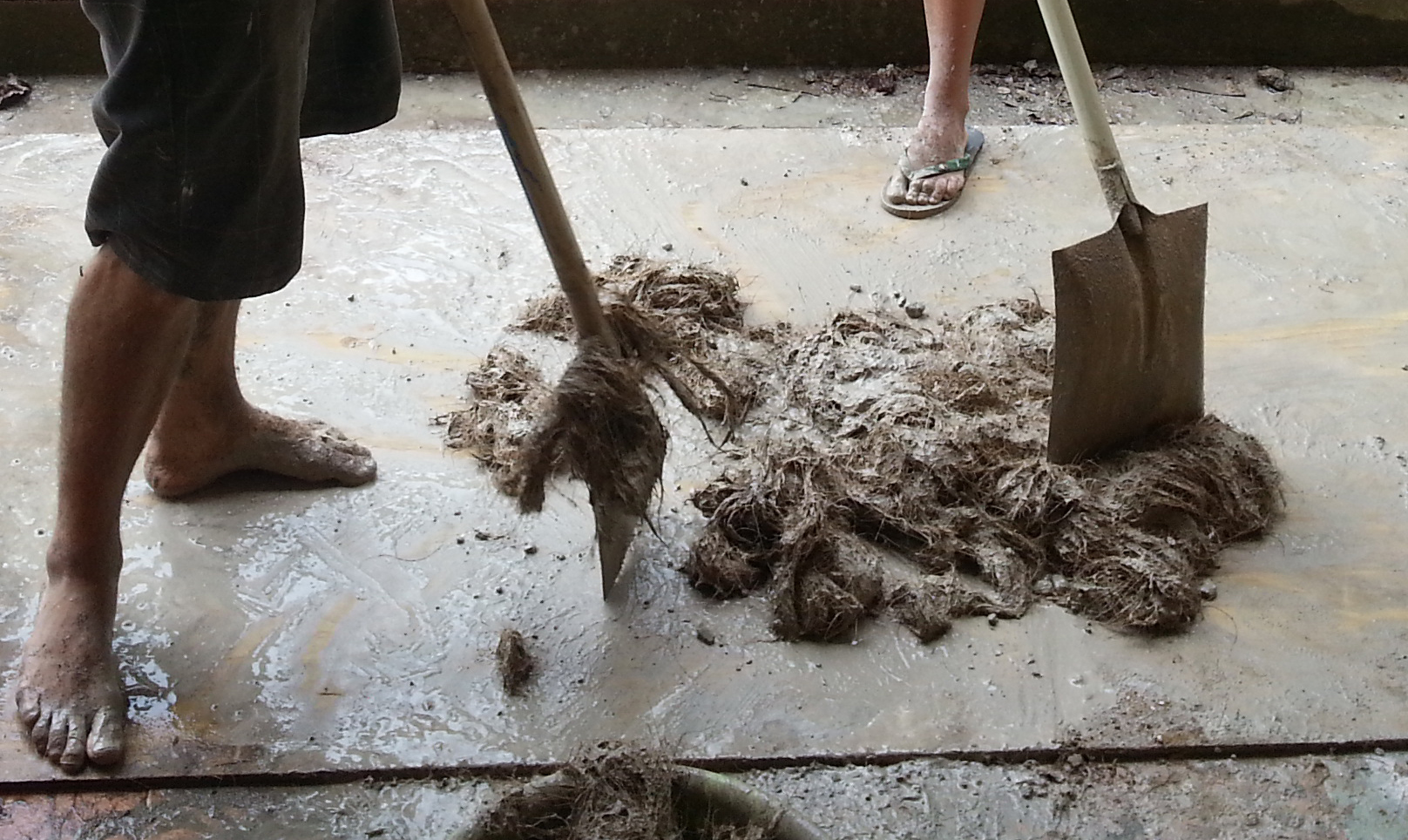
Step by Step
Step 1: Make your formwork, making sure that it is robust and water tight.
Step 2: Pick your vessel of measurement – small wheelbarrows work well, where we counted 50kg cement or 25kg lime as one wheelbarrow.
Step 3: On a clean surface, thoroughly mix the dry cement, lime and sand until it is a uniform colour
Step 4: Soak the coconut coir in water. Do this by filling your measuring vessel with 1/3 water and pack in the coconut coir, compressing it down into the water with your hands. Soaked coir will hold itself down after compression. This amount of water also seems to be about right for a workable mix and extra water may not need to be added.
Step 5: Progressively add the soaked coir to the dry mix. Tearing it into smaller clumps helps workability. It’s easier to mix if you spread your pile out rather than heaping it up. Mix until it is all an even colour. There should be no clay-like clumps of sand/lime and similarly no stubborn bunches of coir which are still brown in the middle. The mix should look like grey fibrous slimy coir and have minimal liquid leaking out. It it’s too wet, add some more coir.
Step 6: Pour into the formwork. Well ‘pour’ is the wrong verb. Slop it in in thin layers (less than 100mm). Rake out any stubborn clumps and tamp thoroughly with a stick. A 50x25mm (2″x1″) stick works well at a length to suit the depth of formwork. For a rake, try putting a 4″ nail or two part-way into the end of your stick. This makes breaking up stubborn clumps much easier. The objective is to avoid voids. Don’t pour more than 450mm (18″) at a time unless your formwork is very strong.
Step 7: Allow 5 days before striking the formwork.
A Note on this Coco-crete mix
We have used the above mix for self supporting non loadbearing walls up to 1800mm high and 200mm thick. We have not tested the compressive strength of the above mix yet, although as noted an earlier mix with more cement achieved a characteristic strength of 5N/mm² after 4 months (methodology). Typically, infill walls in Malaysia use sand:cement or clay bricks with a compressive strength of ±2.0 N/mm² so we are over-engineering at present.
We’d like to omit cement all-together, in favour of lime, but in the very high humidity of the Malaysian climate we’re being cautious about how quickly a lime-based biocrete can loose its moisture and achieve minimum strength needed to be self supporting. We think that cement speeds up the curing process, leading to a stronger wall more quickly. For the same reason, coco-crete may not be suitable for bricks given the long time required to cure in the mould.
A similar European product, Hemp-crete, uses a 1:4 mix of lime:hemp shiv as an infill material for framed walls where timber or steel frame does the load-bearing and the biocrete is used for its environmental performance. We will be experimenting with a similar coco-crete mix soon.
A Note on Coconut Coir
Our coconut coir is sourced from a mill near Kudat in Sabah which produces coconut husk mulch for an acacia plantation nursery. The coconut husks themselves are by-products from the copra or coconut oil industry. The coconut husk is the fibrous mass that surrounds the coconut kernel. It is green or yellow when young and seasons to brown. Seasoned coconut husks are fed to the mill where they are ground up, spitting out crumbly mulch at one side and tough long fibres at the other. The mill that we go to has no other use for the fibres and if we don’t use them, they are burned.
A Note on Sustainability
A drawback of our method so far is that cast in-situ walls use a lot of timber for formwork that may go to waste afterwards. On the other hand, thick monolithic walls may enhance the potential beneficial properties of coco-crete as follows:
1. Low-carbon material
2. Thermally resistant material (insulating – keeps sun’s heat out)
3. Hygroscopic material (water can go in and out – cooling by evaporation)
4. Uses locally available waste natural fibre (benefits people and planet)
5. Can be crushed and safely added to soil/landfill (recyclable by decomposition)
If anyone can help us to substantiate or disprove these claims we’d like to hear from you.
We have been using coco-crete on a community project at Tinangol near Kudat in Sabah.




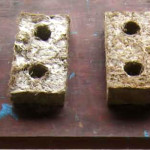
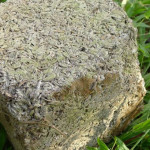

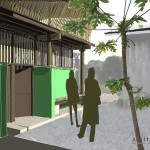
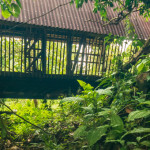
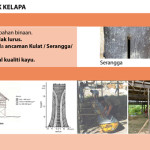
Sir please give me some more details about biocrete block.As i am in last year engineering so i want to this topic as a final year project..
Hi,
I am interested to build an eco house by copying the hemp/lime “cast in” concept. However, I would replace the hemp fibers with coconut husk fibers (in the dominican republic).
The wooden frame work gives the strengh to the roof and walls, and then the coco fibers + lime are casted in. (no sand, no cement.)
In your opinion, what would be the drawbacks from using this technique?
thanks for inspiring so many of us 🙂
Dear Jean-Charles. Coconut coir works very well and creates a stronger bio-crete. The only problem is workability: it’s harder to mix than shorter fibres such as rice husk.
Bio-crete cast-in to timber frame is very effective. The lime also helps to protect the timber from termites. To get the passive cooling benefit, the walls need to be at least 200mm (8″) thick, which gives you a challenge/opportunity for how to design the timber framing.
Finally, think about your formwork, which can be temporary or permanent. If temporary, plywood for example, you can take it off when the bio-crete is set and re-use it. In this case finish the bio-crete with a lime:sand plaster or mud:lime plaster. If you’re using permanent formwork: it needs to look good and be water permeable. We’ve always used timber, but I’m sure there are other options.
Please share your results with us.
Best wishes, Ian